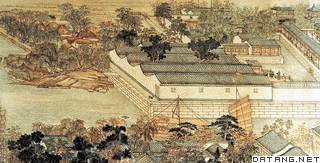1) evernormal


平常仓贮
2) the ever normal granary


常平仓
1.
In this essay the author takes an American example of establishment of the ever normal granary system in the 1930s, and to curb the depressed farm conditions, to note that the application of the ancient idea to the modern time keeps meaningful.
作者通过一个当代的具体实例——对美国新政农业政策借鉴中国古代常平仓思想 ,建立常平仓制度 ,解决农业生产过剩问题并取得较大成果的回顾 ,试图揭示 ,今天研究中国经济思想史仍然具有很强的现实意
2.
As an important legal system, the Agricultural Adjustment Act of 1938 taking the ever normal granary plan of the Chinese idea as its core content, keeps the fundamental law for the modern American agricultural prosperity.
这项法律的核心内容是来自于中国古代的常平仓思想。
3) ever normal granary


常平仓
1.
The Influence of the Idea of Ever Normal Granary on Henry A. Wallace and the Agricultural Adjustment Act in the New Deal;
中国古代常平仓思想对美国新政农业立法的影响
2.
After more than 2,000 years of its evolution, this ancient idea of stabilizing economy by means of ever normal granary has stayed put and has been updated in China.
古代常平仓制度历经 2 0 0 0多年演变 ,常平仓制度稳定经济的思想历久常新。
3.
Towards the end of 1930s, the Agricultural Adjustment Act (1938), taking the ide a of ever normal granary from China as its core, helped to lay a solid foundatio n for the finish of twenty year s depression of American agriculture and keeping it abundant till now.
20世纪 30年代末 ,美国农业长达 2 0年的萧条结束 ,至今保持着丰裕局面 ,奠定这个基础的制度因素之一是 1938年颁布的《农业调整法》,它的核心内容是源于中国的常平仓思想。
4) Changping Can Law


常平仓法
5) SONG:ever normal granary office


常平仓司
6) Changping Storage in the Song Dynasty


宋代常平仓
1.
On WANG An-shi s Reform of Changping Storage in the Song Dynasty and Its Effects;


论王安石对宋代常平仓的改革及影响
补充资料:常平仓
| 常平仓 中国古代政府为调节粮价、储粮备荒以供应官需民食而设置的粮仓。常平源于战国时李悝在魏所行的平籴,即政府于丰年购进粮食储存,以免谷贱伤农;歉年卖出所储粮食以稳定粮价。汉武帝时,桑弘羊创立平准法,依仗政府掌握的大量钱帛物资,在京师贱收贵卖以平抑物价。宣帝时把平准法着重施之于粮食的收贮,在一些地区设立了粮仓,收购价格过低的粮食入官,以“利百姓”。这种粮仓已有常平仓之名。五凤四年(前54年)常平仓作为一项正式的制度推行于较大范围之内。元帝初元五年(前44年)废。汉以后,常平仓置废不常。隋唐时期常平仓制度有所变化。唐玄宗天宝四载(745)丰收,命义仓亦准常平法收籴,义仓遂兼有常平职能。天宝八载,关内、河北、河东、河西、陇右、剑南、河南、淮南、山南、江南十道常平仓积粮460余万石。宪宗元和元年(806),规定诸州府于每年地亩税内十分取二以充常平仓及义仓,依例籴、粜或赈、贷。自此常平仓与义仓职能合一,并称常平义仓。宋景德三年(1006)后,除沿边州郡外,全国先后普遍设置。各州按人口多少,量留上供钱一二万贯至二三千贯为籴本,每岁夏秋谷贱,增市价三五文收籴,遇谷贵则减价出粜,所减不得低于本钱。若三年以上未经出粜,即回充粮廪,易以新粮。景祐以后,由于常平积有余而三司兵食不足,常平钱谷经常被挪移助充军费,常平仓已经名存实亡。金代章宗明昌五年(1194),全国置仓计519处,积粮3786万余石。元世祖至元八年(1271)复命各路立仓,由本处正官兼管,按户数收贮米粟,增时价十分之二经常收籴,不得摊派百姓。但到元末,常平仓弊端百出,行省所发籴本被各级官吏层层克扣,胥吏与里正主首又从中作弊,贫民反不能受益。明太祖洪武三年,命州县皆于四乡各置预备仓(永乐中移置城内),出官钞籴粮贮之以备赈济,荒年借贷于民,秋成偿还,遂为一代定制,取代了常平仓。明末又在辽东、延绥一些边镇设立常平仓。
清顺治年间,各府、州、县俱置常平及义、社仓,责成道员专管,每年造册报户部;十七年,定仓谷籴粜之法,春夏出粜,秋冬籴还,平价出息,如遇灾荒,即以赈济。康熙年间,又定春借秋还,每石取息一斗;各地常平、义仓储粮永留本境备赈。并规定了大、中、小州县应储粮数。后以籴本不足,命州县官“劝输”常平等仓粮。“永留本境”的规定也往往不能执行。中叶以后,弊端日甚,各地常平仓多数钱、谷两虚,徒有其名,起不到平抑粮价和备荒的作用。 |
说明:补充资料仅用于学习参考,请勿用于其它任何用途。
参考词条
